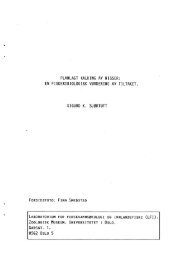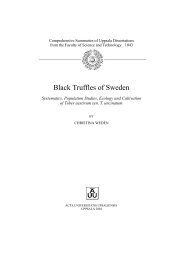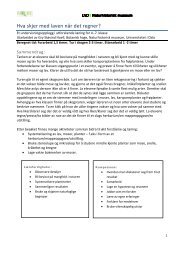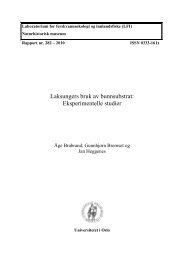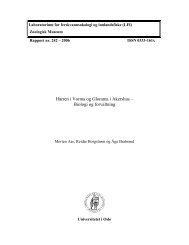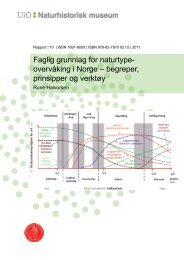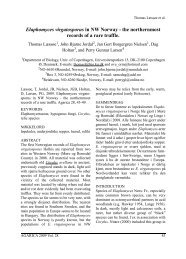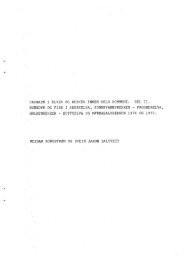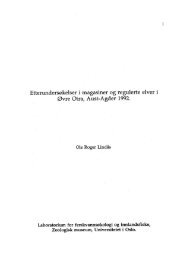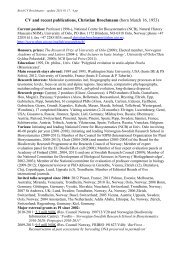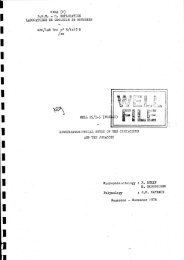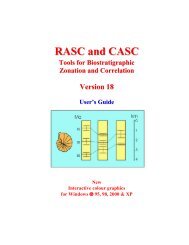Truffle trouble: what happened to the Tuberales?
Truffle trouble: what happened to the Tuberales?
Truffle trouble: what happened to the Tuberales?
- TAGS
- truffle
- www.nhm.uio.no
You also want an ePaper? Increase the reach of your titles
YUMPU automatically turns print PDFs into web optimized ePapers that Google loves.
1094 T. Læssøe, K. Hansen<br />
Table 2 – Different recent classification schemes of<br />
pezizalean truffles<br />
<strong>Tuberales</strong><br />
(Korf 1973a)<br />
Hypogeous<br />
Pezizales<br />
(Trappe 1979)<br />
Suggested<br />
classification of<br />
hypogeous Pezizales<br />
Elaphomycetaceae Pezizaceae Pezizaceae<br />
Elaphomyces Amylascus Amylascus<br />
Mycoclelandia Cazia<br />
(as Clelandia)<br />
Eremiomyces<br />
Hydnotryopsis Hydnobolites<br />
Peziza spp.<br />
Hydnotryopsis<br />
Tirmania<br />
Kalaharituber<br />
Mattirolomyces<br />
Terfeziaceae Terfeziaceae<br />
Mycoclelandia<br />
Carbomyces Choiromyces<br />
Pachyphloeus<br />
Delastria Delastria<br />
Peziza spp.<br />
Mukagomyces Hydnobolites<br />
Ruhlandiella<br />
Paradoxa Pachyphloeus<br />
Sphaerozone<br />
Picoa Terfezia<br />
Terfezia<br />
Terfezia<br />
Tirmania<br />
Tirmania<br />
Helvellaceae Helvellaceae<br />
Hydnotrya Balsamia<br />
Tuberaceae Dingleya Barssia<br />
Barssia<br />
Balsamia<br />
Fischerula Helvella astieri<br />
Caulocarpa<br />
Balsamiaceae Tuberaceae<br />
Choiromyces<br />
Balsamia Choiromyces<br />
Elderia<br />
Barssia Dingleya<br />
Fischerula<br />
Picoa Labyrinthomyces<br />
Lespiaultinia<br />
Paradoxa<br />
Labyrinthomyces Tuberaceae<br />
Reddelomyces<br />
Hydnobolites<br />
Paradoxa<br />
Tuber<br />
Hydnoplicata<br />
Tuber<br />
Hydnotrya<br />
Pachyphloeus<br />
Phyma<strong>to</strong>myces<br />
Piersonia<br />
Pro<strong>to</strong>genea<br />
Pseudobalsamia<br />
Stephensia<br />
Tuber<br />
Pyronemataceae<br />
Geopora cooperi<br />
Hydnocystis<br />
Morchellaceae/<br />
Discinaceae<br />
Gymnohydnotrya<br />
Hydnotrya<br />
Fischerula<br />
Leucangium<br />
Pyronemataceae<br />
Labyrinthomyces Genabea<br />
Paurocotylis<br />
Genea<br />
Petchiomyces<br />
Geopora cooperi<br />
Sphaerozone<br />
Gilkeya<br />
Stephensia<br />
Hydnocystis<br />
Paurocotylis<br />
Petchiomyces<br />
Geneaceae Geneaceae Phaeangium ¼ Picoa?<br />
Genea Genea Picoa<br />
Hydnocystis Genabea Sphaerosoma<br />
Petchiomyces Stephensia<br />
Glaziellaceae<br />
Glaziella<br />
Carbomycetaceae Carbomycetaceae<br />
Carbomyces Carbomyces<br />
The adopted classification (right column) is based on recent molecular<br />
phylogenies combined with morphological characters.<br />
Hydnobolites cerebriformis, Pachyphloeus citrinus, and Mattirolomyces<br />
terfezioides (as Terfezia), <strong>to</strong> be uni-nucleate. This<br />
led Zhang <strong>to</strong> propose <strong>the</strong> synonymy of Geneaceae with<br />
Pyronemataceae, and fur<strong>the</strong>rmore, restricted Terfeziaceae <strong>to</strong><br />
uninucleate taxa (now incorporated in <strong>the</strong> Pezizaceae). The Helvellaceae<br />
have been considered <strong>to</strong> be defined by tetra-nucleate<br />
spores, but it is now evident that this number is a plesiomorphic<br />
character (also present in Discinaceae and some taxa of<br />
Tuberaceae) and thus has very limited discriminative value.<br />
The placement of f.ex Hydnotrya (Trappe 1979) and Choiromyces<br />
(e.g. Pegler et al. 1993) in <strong>the</strong> Helvellaceae was argued along<br />
those lines. However, molecular phylogenetic analyses of<br />
SSU and LSU rDNA suggest that Hydnotrya belongs <strong>to</strong> Discinaceae<br />
and Choiromyces <strong>to</strong> Tuberaceae (O’Donnell et al. 1997)(Fig 3).<br />
Ecological aspects of <strong>the</strong> truffle syndrome<br />
Various evolutionary processes may be involved in <strong>the</strong> truffle<br />
syndrome, but <strong>the</strong> most generally accepted is <strong>the</strong> avoidance<br />
of desiccation (e.g. Thiers 1984). The high truffle diversity in<br />
arid areas favours this hypo<strong>the</strong>sis. Some truffles, like Tuber aestivum<br />
and T. melanosporum, clearly have an outer layer that renders<br />
protection, <strong>to</strong> both mechanical and desiccation stresses,<br />
but many o<strong>the</strong>rs have very delicate fruit bodies, often formed<br />
in <strong>the</strong> upper soil layers, where desiccation pressures can exist,<br />
although of a less harsh nature than above ground. Ano<strong>the</strong>r<br />
driving force could be protection against above-ground predation<br />
of immature ascomata. At maturity <strong>the</strong> production of pungent<br />
volatile compounds attracts preda<strong>to</strong>rs of a kind <strong>the</strong> truffles<br />
have co-evolved with, or at least adapted <strong>to</strong>, in order <strong>to</strong> facilitate<br />
spore dispersal. Pacioni et al. (1990) speculated on o<strong>the</strong>r functions<br />
of <strong>the</strong> compounds, including microbial control of <strong>the</strong> micro-rhizosphere.<br />
Spores of hypogeous fungi probably persist for<br />
longer in <strong>the</strong> soil than those of wind-dispersed relatives, which<br />
presumably is of importance in respect <strong>to</strong> life in a xeric environment<br />
and as ec<strong>to</strong>mycorrhiza formers (e.g. Miller et al. 1994).<br />
It is generally assumed that most hypogeous fungi, including<br />
those in <strong>the</strong> Pezizales, form ec<strong>to</strong>mycorrhiza. Direct proof of<br />
this has not been established in all cases, but circumstantial<br />
evidence clearly indicates <strong>the</strong> validity of this assumption<br />
(e.g. Pacioni & Comandini 1999; Montecchi & Sarasini 2000).<br />
Early on some of <strong>the</strong>se relationships were considered parasitic,<br />
e.g. those with Cistaceae (Singer 1961). Awameh &<br />
Alsheikh (1979) and Awameh et al. (1979) claimed that some<br />
Terfezia and Tirmania spp. form ec<strong>to</strong>mycorrhiza with Helian<strong>the</strong>mum,<br />
but Kovács et al. (2003) have pointed out some important<br />
morphological discrepancies compared <strong>to</strong> typical EM<br />
structures casting doubt on <strong>the</strong>se conclusions. Based on<br />
morphotyping and sequencing of ec<strong>to</strong>mycorrhizal root tips,<br />
Tedersoo et al. (2006) identified 33 species of Pezizales <strong>to</strong> be<br />
ec<strong>to</strong>mycorrhizal, including species of Genea, Geopora, Helvella,<br />
Hydnotrya, Pachyphloeus, Peziza, Sarcosphaera, and Tuber. They<br />
hypo<strong>the</strong>sized that <strong>the</strong> ec<strong>to</strong>mycorrhizal lifestyle is a precondition<br />
for <strong>the</strong> switch <strong>to</strong> hypogeous fruiting. Most well-known<br />
mycorrhizal trees would appear <strong>to</strong> be involved in associations<br />
with pezizalean truffles, including various members of <strong>the</strong><br />
Fagaceae, Betulaceae, Pinaceae, and Myrtaceae. It is generally<br />
assumed that truffles prefer warm, fairly dry climates and<br />
calcareous soils, but this may be slightly overstated due <strong>to</strong><br />
<strong>the</strong> emphasis of requirements for <strong>the</strong> edible Tuber species.<br />
Still, <strong>the</strong> overall species diversity appears <strong>to</strong> be highest in<br />
alkaline soils in warm temperate <strong>to</strong> subtropical climates.<br />
Desert areas around <strong>the</strong> world also have a special truffle



